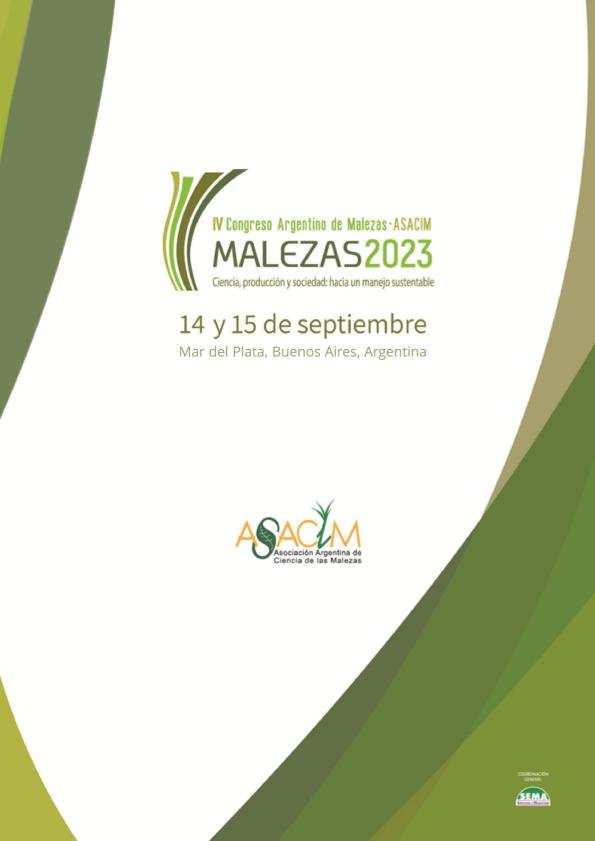Evento
Como consecuencia del uso reiterado de herbicidas, poblaciones de raigrás (Lolium sp.) han desarrollado resistencias múltiples a herbicidas que dificultan su control. Entender atributos ecofisiológicos como la germinación, sería de gran utilidad para diseñar estrategias de manejo más sustentables. El objetivo del trabajo consistió en evaluar la germinación de poblaciones de raigrás con distintos mecanismos de resistencia bajo un gradiente de temperaturas alternadas. Los ensayos se realizaron siguiendo un modelo completamente aleatorizado con cuatro réplicas. Se utilizaron semillas post-maduradas de poblaciones de raigrás susceptible (Pb1), con resistencia a glifosato (Pb2), múltiple a inhibidores de la ALS y de la ACCasa (Pb3) y múltiple a glifosato e inhibidores de la ALS y de la ACCasa (Pb4) que fueron incubadas bajo un gradiente de temperaturas alternadas (5/15, 10/20, 15/25, 20/30 y 25/35 °C) con un fotoperíodo de 12/12. La germinación se contabilizó diariamente durante dos semanas y se estimó la germinación máxima (Gmax) y la tasa de germinación media (TG50) enfunción a las semillas viables. En todos los casos, Pb1 alcanzó los mayores y Pb4 losmenores valores de Gmax diferenciándose entre sí en los tres rangos más bajos detemperaturas (p<0,05). El régimen térmico 20/30 °C mostró las máximas tasas degerminación mientras que para Pb4 se evidenció una menor TG50 en el rango térmicoinmediato superior e inferior al óptimo (p<0,05). A partir de los presentes resultados, será necesario determinar si las diferencias observadas entre Pb4 y el resto de laspoblaciones se vinculan con un costo biológico debido a la resistencia múltiple aglifosato e inhibidores de la ALS y de la ACCasa. As a consequence of the repeated use of herbicides, populations of ryegrass (Lolium sp.) have developed multiple resistances to herbicides that make their control difficult. Understanding ecophysiological attributes such as germination would be very useful to design more sustainable management strategies. The objective of this work was to evaluate the germination of ryegrass populations with different resistance mechanisms under an alternating temperature gradient. The trials were conducted following a completely randomized model with four replicates. Post-mature seeds of susceptible (Pb1), glyphosate resistant (Pb2), multiple ALS and ACCase inhibitor resistant (Pb3) and multiple glyphosate, ALS and ACCase inhibitor resistant (Pb4) populations of ryegrass were incubated under an alternating temperature gradient (5/15, 10/20, 15/25, 20/30 and 25/35 °C) with a 12/12 photoperiod. Germination was estimated daily for two weeks and maximum germination (Gmax) and mean germination rate (TG50) were estimated as a function of viable seeds. In all cases, Pb1 reached the highest and Pb4 the lowest Gmax values differing from each other in the three lowest temperature ranges (p<0.05). The thermal regime 20/30 °C showed the highest germination rates while for Pb4 a lower TG50 was evidenced in the thermal range immediately above and below the optimum (p<0.05). The present results indicate the need to determine if the differences observed between Pb4 and the rest of the populations are linked to a biological cost due to multiple resistance to glyphosate and ALS and ACCase inhibitors.
Germinación de poblaciones de Lolium Sp. con diferentes resistencias a herbicidas
Carreño, Salvador Santiago; Chantre Balacca, Guillermo Ruben ; Sabbatini, Mario Ricardo
; Sabbatini, Mario Ricardo ; Gigón, Ramón; Yanniccari, Marcos Ezequiel
; Gigón, Ramón; Yanniccari, Marcos Ezequiel ; Longás, María de Las Mercedes
; Longás, María de Las Mercedes
 ; Sabbatini, Mario Ricardo
; Sabbatini, Mario Ricardo ; Gigón, Ramón; Yanniccari, Marcos Ezequiel
; Gigón, Ramón; Yanniccari, Marcos Ezequiel ; Longás, María de Las Mercedes
; Longás, María de Las Mercedes
Tipo del evento:
Congreso
Nombre del evento:
IV Congreso Argentino de Malezas
Fecha del evento:
14/09/2023
Institución Organizadora:
Asociación Argentina de Ciencias de las Malezas;
Título del Libro:
IV Congreso Argentino de Malezas
Editorial:
Asociación Argentina de Ciencias de las Malezas
Idioma:
Español
Clasificación temática:
Resumen
Palabras clave:
RESISTENCIA
,
RAIGRAS
,
GERMINACION
Archivos asociados
Licencia
Identificadores
Colecciones
Eventos(CERZOS)
Eventos de CENTRO REC.NAT.RENOVABLES DE ZONA SEMIARIDA(I)
Eventos de CENTRO REC.NAT.RENOVABLES DE ZONA SEMIARIDA(I)
Citación
Germinación de poblaciones de Lolium Sp. con diferentes resistencias a herbicidas; IV Congreso Argentino de Malezas; Mar del Plata; Argentina; 2023; 130-131
Compartir



